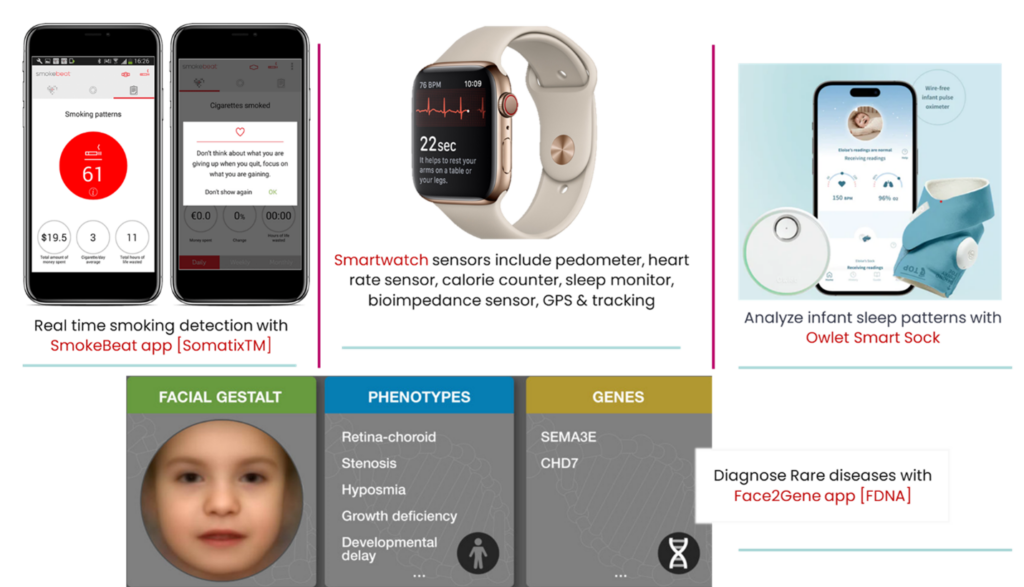Authors: Sherin Ann Eapen – Senior Scientific Analyst I, Manti Kumar Saha – Senior Scientific Specialist I, Debamitra Chakravorty – Technical Program Manager II, Philge Philip – Senior Scientific Manager I
Introduction:
If you are trying to explore the nexus between biomarker discovery, AI/ML advancements, and digital transformation in medicine, then you are in the right place.
Welcome to the forefront of revolutionizing innovation in drug discovery, development, and healthcare!
Over the years we have seen how digitization in healthcare and personalized treatments both have led to groundbreaking inventions. One such advancement is the discovery of digital biomarkers powered by the capabilities of Artificial Intelligence (AI) and Machine Learning (ML). In this blog we talk about how the convergence of AI and ML technologies with the quest for digital biomarkers has sparked a paradigm shift in drug discovery and digital medicine.
Biomarkers: The Foundation of Medical Insights
Traditionally, biomarkers are crucial for medical diagnosis and prognosis. However, validating new biomarkers poses challenges in drug discovery. Traditional methods like immunohistochemistry (IHC) need careful optimization for visualizing cancer-related protein markers. While conventional approaches have advanced our understanding of disease biology, modern methodologies, utilizing digital technologies and computational tools, are poised to revolutionize precision medicine (see Figure 1).

Figure 1: Traditional Vs. Recent Approaches in biomarker discovery
Traditional biomarkers, such as blood pressure and tumor markers like prostate-specific antigen (PSA), provide valuable diagnostic information but have limitations in temporal resolution and require periodic sampling. Digital biomarkers, derived from everyday digital devices like wearables and mobile apps (Figure 2), offer non-invasive, real-time insights into heart rate, sleep patterns, and activity levels (14). These indicators leverage individuals’ digital footprints, encompassing physiological parameters, behavioral patterns, and environmental effects. Utilizing wearable devices in clinical trials reduces inconvenience for participants, minimizing travel and recording time, while providing a comprehensive, continuous view of physiological data essential for assessing a drug’s impact.

Figure 2: Digital Biomarkers (Source: SmokeBeat Somatix, Smart-watch by Apple, Face2Gene FDNA, Owlet Smart Sock)
Continuous glucose monitoring (CGM) systems utilize wearable sensors to track blood glucose levels in diabetic patients, enabling personalized diabetes management. SmokeBeat, a mobile application by SomatixTM, employs smartphone sensors like the microphone and accelerometer to analyze sound and hand-to-mouth movements, identifying smoking events (1). This helps monitor smoking frequency, duration, and intensity over time, revealing patterns or triggers associated with smoking behavior.
Key players like ActiGraph, Fitbit Health Solutions, Biogen, F. Hoffmann-La Roche Ltd., and Huma drive innovation in the digital biomarkers market (2). In September 2022, Nutromics secured USD 14 million funding from Dexcom Ventures for a ‘lab-in-a-patch’ platform using DNA sensor technology to track various targets, including disease biomarkers and hard-to-dose drugs (2).
Software as a Medical Device (SaMD) empowers clinicians with tools for diagnosis, treatment planning, and patient monitoring in the digital biomarkers realm. SaMD plays a pivotal role in analyzing complex datasets from wearables, mobile health apps, and electronic health records (EHRs).
Integrating digital biomarkers into healthcare systems holds promise for enhancing patient care, and an increasing number of new product launches is expected to drive demand. Leveraging digital technologies, researchers can accelerate drug discovery, development, and repurposing efforts, improving patient outcomes through real-time insights, comprehensive data collection, remote monitoring, early detection and prediction of drug effects, and efficiencies in clinical trials, fostering potential for personalized medicine approaches.
Digital biomarkers transform healthcare, yet challenges like data privacy, interoperability, and validation persist. AI and ML address these issues, enhancing data privacy through encryption, automating data integration for interoperability, and validating biomarker efficacy by correlating with clinical outcomes. AI and ML also aid regulatory compliance through automated monitoring and risk assessment. However, detailed insights into how AI/ML empower biomarker discovery warrant further discussion.
AI/ML roadmap to biomarker discovery landscape
AI/ML empowers biomarker discovery in medicine by unraveling complexities in multi-omics datasets (genomics, proteomics, and metabolomics) (Figure 3). Over the last two decades, ~1200 articles on ML and biomarker discovery have been published in PubMed (3).
In genomics, AI algorithms, such as convolutional neural networks (CNNs), decode genomic sequences, identifying variations with precision. DeepVariant, using deep learning, enhances genomic variant identification for precise disease diagnosis (4).
In proteomics, AI improves mass spectrometry-based protein analysis. Tools like MaxQuant employ AI for label-free quantification, while AlphaFold predicts protein structures accurately, advancing drug discovery (5).
In metabolomics and epigenetics, AI techniques analyze profiles to identify signatures associated with diseases. XCMS detects metabolites using ML, aiding biomarker discovery. In epigenetics, AI algorithms decipher chromatin accessibility and histone modifications, revealing gene regulatory networks (6).
For a holistic understanding, multi-omics approaches are essential. Ghaemi et al. used AI in predictive modeling with multi-ome data, uncovering interactions and studying gestational age (6).
In drug discovery, AI bridges biomarker discovery to drug design, facilitating novel molecules, optimizing drug combinations, and repurposing molecules (7). AI also holds potential in personalized medicine, tailoring drug combination therapy based on patient data through AI/ML techniques, particularly in personalized cancer vaccine development (8).

Figure 3: AI/ML based workflow for biomarker discovery
Applying AI/ML to traditional biomarker discovery in omics data extends beyond conventional methods. In digital biomarkers, AI enhances real-time patient data for a dynamic understanding of physiological responses and treatment outcomes.
AI with Digital Biomarkers
AI revolutionizes digital biomarkers, providing precise insights and personalized interventions in healthcare (9). Platforms like Biofourmis and Owlet Smart Sock utilize AI for ECG signal analysis in heart failure patients and infant sleep pattern assessment, respectively (9, 10).
AI automates the detection of subtle changes in digital biomarkers, aiding early detection of health abnormalities. Face2Gene app uses AI-powered facial recognition for diagnosing rare genetic disorders based on facial phenotypes (11).
In Drug Discovery and Development (DDD), AI-driven digital biomarkers enhance clinical trials’ efficiency. Examples include Roche achieving a 70% reduction in sample size and FDA endorsing a digital outcome measure in Bellerophon’s trial, reducing the sample size by over 50% (12). AstraZeneca’s CRESCENDO trial utilizes smart spirometry and cloud-based AI for data quality control, aiming to halve treatment duration (12).
Continuous monitoring outside clinical environments provides insights into long-term drug effects, identifies adverse events earlier, and informs drug development decisions. Integrating digital endpoints into pre-clinical studies offers valuable data on experimental drugs’ effects (12).
As AI technologies progress, AI-driven omics data analysis and digital biomarkers will play pivotal roles in drug discovery and digital healthcare.
Excelra’s Edge on AI/ML-induced Biomarker Identification
Excelra adeptly integrates evolving technologies for biomarker discovery, offering robust support for AI/ML-enabled approaches. In the oncology domain, an in-house ML model utilizes expression data from CCLE, COSMIC, and ArrayExpress, employing random forest (RF) regression and recursive feature elimination (RFE) with ridge regression for feature selection (Figure 4). Trained with SVM and RF, the model accurately predicted drug response for 9 out of 10 patients, achieving an 82% accuracy in identifying drug response biomarkers. Excelra’s commitment to personalized medicine and biomarker identification is exemplified through this cutting-edge service.

Figure 4: Excelra’s Workflow for predictive biomarker identification
In drug discovery, Excelra excels in utilizing AI/ML methods, employing algorithms like Latent Dirichlet Allocation (LDA), Random Forest (RF), and Support Vector Machine (SVM) to predict drug combination success and disease indications. Demonstrating a remarkable 97.67% accuracy in a test set with over 8000 disease indications, Excelra showcases the effectiveness of its predictive models.
As biomedicine embraces digital innovations, Excelra’s expertise in AI/ML for drug discovery suggests potential for expanding into the digital biomarkers space, complementing its existing portfolio of silico early drug discovery and development services.
What Does the Future Hold?
The future of healthcare and medicine is undergoing a profound transformation, with digital biomarkers emerging as powerful tools in reshaping diagnostics and treatment strategies. Integrating multi-omics data with ML offers the potential to identify novel biomarkers, thereby enhancing early disease detection and personalized interventions. The major challenges in this approach of biomarker discovery include availability of quality data and model interpretability. But with the advent of eXplainable AI (XAI) the trust in AI models is expected to improve (13). By incorporating XAI models in the domain of healthcare, the benefits of AI-driven biomarker insights, and digital biomarkers, while maintaining transparency and interpretability in the decision-making process can be optimally harnessed (13). Future research will facilitate more interpretable AI/ML models for biomarker discovery, which in turn will pave the way for advancements in this field and its acceptability in the medical domain.
Conclusion
The dynamic interplay of biomarker discovery, with a focus on digital biomarkers and AI/ML advancements opens unprecedented avenues for transformative drug discovery, development, and healthcare. The transition from conventional diagnostics to digital biomarker-driven insights represents a paradigm shift in traditional medicine, empowering clinicians to make more informed decisions, and tailor treatments to individual patient profiles. The shift from a one-size-fits-all approach to precision and personalized medicine is no longer a distant dream but a tangible reality, thanks to the capabilities of AI in decoding the intricacies of biomedical data.
The road ahead is exciting, and the possibilities are limitless!
References
1. SmokeBeat App by Somatix:
Somatix | Real-Time Smoking Detection and Intervention
2. Digital Biomarkers Market Size & Share Analysis – Growth Trends & Forecasts (2024 – 2029):
www.mordorintelligence.com
3. PubMed Statistics on Machine Learning and Biomarker Discovery Articles:
pubmed.ncbi.nlm.gov
4. Ryan Poplin, Pi-Chuan Chang, David Alexander, Scott Schwartz, Thomas Colthurst, Alexander Ku, Dan Newburger, Jojo Dijamco, Nam Nguyen, Pegah T. Afshar, Sam S. Gross, Lizzie Dorfman, Cory Y. McLean, and Mark A. DePristo. A universal SNP and small-indel variant caller using deep neural networks. Nature Biotechnology 36, 983–987 (2018).
doi: https://doi.org/10.1038/nbt.4235
5. Mihaly Varadi, Stephen Anyango, Mandar Deshpande, Sreenath Nair, Cindy Natassia, Galabina Yordanova, David Yuan, Oana Stroe, Gemma Wood, Agata Laydon, Augustin Žídek, Tim Green, Kathryn Tunyasuvunakool, Stig Petersen, John Jumper, Ellen Clancy, Richard Green, Ankur Vora, Mira Lutfi, Michael Figurnov, Andrew Cowie, Nicole Hobbs, Pushmeet Kohli, Gerard Kleywegt, Ewan Birney, Demis Hassabis, Sameer Velankar. AlphaFold Protein Structure Database: massively expanding the structural coverage of protein-sequence space with high-accuracy models. Nucleic Acids Research, Volume 50, Issue D1, 2022, Pages D439–D444.
https://doi.org/10.1093/nar/gkab1061
6. Ghaemi MS, DiGiulio DB, Contrepois K, Callahan B, Ngo TTM, Lee-McMullen B, Lehallier B, Robaczewska A, Mcilwain D, Rosenberg-Hasson Y, Wong RJ, Quaintance C, Culos A, Stanley N, Tanada A, Tsai A, Gaudilliere D, Ganio E, Han X, Ando K, McNeil L, Tingle M, Wise P, Maric I, Sirota M, Wyss-Coray T, Winn VD, Druzin ML, Gibbs R, Darmstadt GL, Lewis DB, Partovi Nia V, Agard B, Tibshirani R, Nolan G, Snyder MP, Relman DA, Quake SR, Shaw GM, Stevenson DK, Angst MS, Gaudilliere B, Aghaeepour N. Multiomics modeling of the immunome, transcriptome, microbiome, proteome and metabolome adaptations during human pregnancy. Bioinformatics. 2019 Jan 1;35(1):95-103.
doi:10.1093/bioinformatics/bty537. PMID: 30561547; PMCID: PMC6298056.
7. Boniolo F, Dorigatti E, Ohnmacht AJ, Saur D, Schubert B, Menden MP. Artificial intelligence in early drug discovery enabling precision medicine. Expert Opin Drug Discov. 2021 Sep;16(9):991-1007.
doi:10.1080/17460441.2021.1918096. Epub 2021 Jun 2. PMID: 34075855
8. Xu Z, Wang X, Zeng S, Ren X, Yan Y, Gong Z. Applying artificial intelligence for cancer immunotherapy. Acta Pharm Sin B. 2021 Nov;11(11):3393-3405.
doi:10.1016/j.apsb.2021.02.007. Epub 2021 Feb 11. PMID: 34900525; PMCID: PMC8642413
9. Biofourmis:
Biofourmis | Revolutionize the delivery of care
10. Owlet Smart Sock:
Baby Sleep Monitor: Track Your Baby’s Sleep (owletcare.com)
11. Face2Gene app by FDNA:
Home – Face2Gene
12. Ai driven digital biomarkers in clinical drug discovery and development:
www.gohumanfirst.com
13. Sajid Ali, Tamer Abuhmed, Shaker El-Sappagh, Khan Muhammad, Jose M. Alonso-Moral, Roberto Confalonieri, Riccardo Guidotti, Javier Del Ser, Natalia Díaz-Rodríguez, Francisco Herrera. Explainable Artificial Intelligence (XAI): What we know and what is left to attain Trustworthy Artificial Intelligence. Information Fusion, Volume 99, 2023, 101805, ISSN 1566-2535.
https://doi.org/10.1016/j.inffus.2023.101805
14. Roadmap to Biomarker Discovery: Innovations, Opportunities, and Breakthroughs:
Revolutionizing Biomarkers: Advancing Healthcare Innovations (excelra.com)
That’s why you need more than just data. That’s why you need Excelra. Where data means more.


